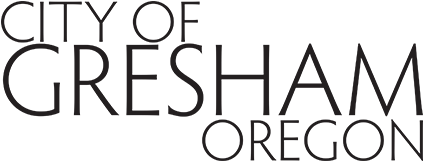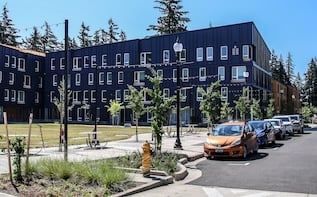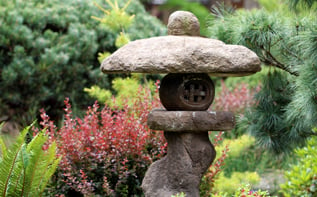Trees
Trees are important
Trees promote soil stability, reduce flooding and runoff, filter air pollution and traffic noise, provide shade, and add to the overall livability of Gresham.
Benefits of trees
- Air conditioning costs are lower in a tree-shaded home; and heating costs are reduced when a home has a windbreak.
- Trees bring natural elements and wildlife habitats into urban surroundings.
- Leaves filter the air we breathe by removing dust and other particles; absorbing carbon dioxide and various air pollutants.
- Trees help cool the environment.
- Learn more about the benefits of trees.
Trees add value
By caring for the trees on your property, you're making an investment for yourself and future generations, as well as the community. Property values of landscaped homes are 5%– 20% higher than non-landscaped homes.
- Regulated tree: Any tree on public or private property that is 8 inches or larger in diameter at four feet high is considered a regulated tree. All street trees, buffer trees, parking lot trees and significant trees are regulated.
- Street tree: A tree located in the public right-of-way between the curb, or edge of roadway, and the property line. Trees located within a public right-of-way where no roadway exists are not considered street trees.
- Significant trees: Trees adopted by the City, with the approval of the property owner, as trees of significance related to a historic event, uniqueness of shape or species, location, age, or functionality.
- Buffer tree: A buffer tree helps provide screening between different land uses such as businesses and single-family homes. The City requires buffers in certain circumstances.
- Tree topping: The severe cutting back of limbs or main stem to stubs larger than three inches in diameter within the tree’s crown to such a degree as to remove the normal top and disfigure the tree. This is a violation and is considered similarly to tree removal.
Trees in Gresham are regulated differently depending on their location, purpose, size, and type. The City regulates cutting trees to make sure too many aren’t cut down at once, trees are replaced to maintain or add to our tree inventory, and damaged or overgrown trees don’t become a hazard to you and your neighbors.
Uncontrolled cutting or destruction of trees within the city decreases the community's livability. It is in the public interest to preserve significant trees, to control the cutting of trees, and to protect trees from damage. Trees in Gresham are regulated differently depending on their location, purpose, size, and significance.
Before removing any tree on your property
To determine whether you need a removal permit, contact the Planner on Duty at 503-618-2780 or POD@GreshamOregon.gov.
- Contact us with any questions about trees in your yard.
- Visit our online permit system to apply for a tree removal permit or exception request. If you do not have access to a computer, contact the Planner on Duty.
When is a permit not required?
Any tree less than 6 inches in diameter measured at 4.5 feet in height may be removed without a permit. Outside sensitive areas trees 6-8 inches in diameter may also be removed without a permit. Relocation of a healthy tree is encouraged.
If your tree is fully collapsed or uprooted in a storm or other hazard event, a tree permit is not required.
- Hazard trees, such as those that are leaning, will still require a permit for removal.
- Imminent hazard trees (a tree where more than 30 percent is estimated to fall within 72 hours into the public right-of-way or onto a target that cannot be protected, restricted, moved, or removed) may be removed immediately before obtaining a permit.
- For imminent hazard tree removal, please send in a retroactive permit within 10 days of removal.
Trees in sensitive areas
In the floodplain, hillside and geologic risk and natural resource overlays, trees more than 6 inches in diameter perform special functions, so they have special protections.
- Contact the Planner on Duty at POD@GreshamOregon.gov for specific regulations.
- Most need to be retained if they are healthy and replaced if they need to be removed.
- You can check whether any of these areas are present on your property by typing your address into Gresham Map.
Regulated trees
Trees more than 8 inches in diameter, measured at 4.5 feet, are regulated trees. Except on properties in the Hillside, Habitat Conservation Area, or Flood Plain areas or as otherwise specified in the City's tree regulations:
- Up to three regulated trees on an undeveloped or low-density residential property 35,000 square feet or less may be removed within a 12-month period.
- Six regulated trees on an undeveloped or low density residential a property over 35,000 square feet may be removed within a 12-month period.
You must get a tree removal exemption before removing regulated trees on your property.
When is a permit required?
Tree locations and permits required:
- Trees located around the perimeter of a site that were required through a development permit as buffer trees: Type I tree removal.
- Trees more than six-inch in diameter, measured at 4.5 feet, in the floodplain, hillside and geologic risk overlay, resource area or potential resource area can be removed with a Type I tree removal permit if they are dangerous or invasive and will need to be replaced at a ratio of one-to-one. Trees that are not dangerous can only be removed with another development permit.
- Trees located within a commercial, industrial, or multi-family landscaping area or a parking lot: Type I tree removal; additionally, these trees must be replaced at a ratio of one-to-one.
- Removal of more than three or six regulated trees (as described above under regulated trees): Type II tree removal permit
- Removal of a significant tree: Type III hearings official decision based on criteria in Section 9.1000 of the Development Code.
- Removal of a street tree: Type I tree removal
If you have any questions about tree removal, contact the Planner on Duty at 503-618-2780 or POD@GreshamOregon.gov for additional information.
Fees and timelines
- Permit: Type I tree removal permit: no fee
Timeline: Up to one week - Permit: Type II tree removal permit: see the City fee schedule
Timeline: Up to three three months - Permit: Type III hearings procedure: no fee
Timeline: Up to four months
How to keep your trees healthy
Tree pruning basics
- No permit is required to prune a tree on private property, unless it is a designated significant tree.
- Property owners are responsible for maintenance of street trees located in the public right-of-way next to their properties.
- Street trees must pruned in accordance with the City's tree-trimming standards.
- All overhanging branches must be at least eight feet above the sidewalk and 12 feet above the street.
- If more than 20 percent of the tree canopy is removed, or if root-pruning is involved, additional requirements may apply.
- If the pruning constitutes tree topping (cutting the normal top off the tree and removing its leading stem), a type I street tree removal permitis required. Tree topping often leads to the tree re-growing in ways that make it unstable or tree death.
More information about pruning
Property owners are responsible for the care and maintenance of street trees located in the public right-of-way next to their properties.
Street trees
Trees located in the public right-of-way between the curb, or edge of roadway, and the property line are street trees. Because street trees are located in the right-of-way, they are regulated by the City and can’t be cut down or planted without a free type I tree removal.Additionally, the trees must be replaced using the approved tree list.
If you are interested in adding more trees on your block, the City’s street tree list offers lots of choices for trees that don’t grow too high, block sun or views, and that thrive in our climate.
Why are street trees a big deal?
The street trees on your block are so much more than just trees. In addition to making a street look more appealing:
- Cars drive more slowly on streets with trees.
- Street trees cut traffic noise.
- Residents walk more on streets with trees.
- Trees increase property value.
- Trees improve air quality.
Trees and sidewalks
When a street tree lifts the sidewalk in front of your house, the sidewalk must be repaired.
- Have a tree care professional provide an assessment and estimate for root-pruning or removal of a tree.
- Contact the City's Public Works Inspector at 503-618-2816 to evaluate sidewalk damage. After the inspection you will need to visit the Permit Center at City Hall to apply for a right-of-way permit. Contact Permit Services at 503-618-2845 for more information.
- If a street tree causing sidewalk damage requires removal to accommodate sidewalk repairs, you must contact the Planner on Duty at 503-618-2780 or POD@GreshamOregon.gov and submit a type I street tree removal permit..
Planting
- When to plant: The best time to plant a tree is when the tree is dormant during the winter months. Trees should be planted between Oct. 1 and April 30 to give them the best change of survival.
- Compact soil: Be sure not to pack the soil too tight when planting the tree. Compact soil makes it difficult for roots to grow outward and downward, which can result in raised sidewalks and an unhealthy tree.
- Mulch: To hold in moisture and discourage the growth of competing weeds, spread mulch around the base of the tree. The mulch should be about four inches deep and kept about six inches from the trunk of the tree. Mulch could include grass clippings, compost, or bark dust.
- Stakes: The tree should be staked for at least the first year after planting. The stakes should be tied loose enough that the tree can sway two inches from side to side.
More about planting new trees
Care
- Trees need water: Your new tree will need 5-10 gallons of water once or twice a week for the first three years after planting. Watering your tree slowly and evenly will promote deep root growth; over watering your tree will promote shallow root growth which will result in raised walkways. A five-gallon bucket with small holes in the bottom is an excellent method for watering your plant slowly..
- Weed around your tree: Other plants around the tree are competing for water. Be sure to remove competing plants several feet around the base of the tree.
- Bark damage: Take care when mowing around the tree, bark damage can weaken the tree and make it susceptible to disease.
- Remove dead branches and suckers: Remove all dead branches in the tree canopy and suckers located at the base of the tree. This will allow the tree to focus its energy where it is needed and desired.
More about pruning young trees
What are significant trees?
Significant trees are trees adopted by the City, with the approval of the property owner, as trees of significance to Gresham. The significance may be related to a historic event, uniqueness of shape or species, location, age or functionality.
Removal of a significant tree must be approved by a Type III hearings official decision, based on criteria in Section 9.1000 of the Development Code.
- Take a tour through Gresham's significant trees.
- Downtown Gresham self-guided tree walk.
- View the location of significant trees in Gresham Map (turn on the significant tree layer)
Nominate a tree
The preservation of significant trees enhances Gresham's livability, history and is an opportunity for recognition and education.
- Nominate a tree by submitting a significant tree nomination form.
- De-list a significant tree by submitting a tree de-list form.
Urban Forestry Subcommittee
Attn: Jim Wheeler
1333 NW Eastman Parkway
Gresham, OR 97030
You may also drop off the forms at City Hall or email them to Jim.Wheeler@GreshamOregon.gov or call 503-618-2881.
Gresham has been designated a Tree City USA by the National Arbor Day Foundation. This honor is the result of work recognizing trees as an important part of Gresham's quality of life.
















